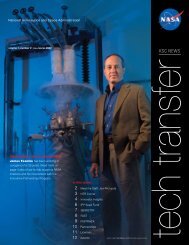2006-2007 - Kennedy Space Center Technology Transfer Office
2006-2007 - Kennedy Space Center Technology Transfer Office
2006-2007 - Kennedy Space Center Technology Transfer Office
- No tags were found...
Create successful ePaper yourself
Turn your PDF publications into a flip-book with our unique Google optimized e-Paper software.
Reversible Chemochromic Hydrogen DetectorsThe Florida Solar Energy <strong>Center</strong> (FSEC), affiliated with the University of CentralHazardous-LeakDetection and Florida, has invented a reversible pigment that changes from light beige to blue whenIsolation exposed to hydrogen and back to light beige when exposed to atmospheric oxygen.In laboratory and environmental studies, the FSEC pigment in its tape form failed tochange color adequately when exposed to hydrogen after one day of exposure at <strong>Kennedy</strong> <strong>Space</strong><strong>Center</strong>’s Beach Corrosion Test Facility. The reversible hydrogen-detecting tape also lost its ability tochange color after being placed in an environmental chamber at 45 °C for one day. The first attemptsat extruding the reversible pigment into various polymers were unsuccessful because of the pigment’spoor thermal stability. The goal of this project was to formulate a pigment with improved thermaland environmental stability for extrusion into a variety of appropriate polymer matrices.The formulation of the reversible hydrogen-detecting pigment was modified by removing onereagent and chemically modifying the hydrogen sensitive ingredient. This was intended to improvethe hydrophobicity of the pigment and alter the thermal degradation mechanism. A sensor with thenew pigment was placed in an oven at 45 °C for 3 days. The figure shows how the newly formulatedpigment changed color (∆E) as it was exposed to 100 percent hydrogen. A larger ∆E indicates agreater color difference. The maximum ∆E for the modified sensor decreases by less than 2 followingheat treatment when compared to an unheated sample. With a similar heat treatment, the originalreversible pigment lost its sensitivity to hydrogen, since the maximum ∆E attained is less than 3.After changing color when heated to 45°C, the modified pigment was extruded at high temperaturesinto a tape. The extruded tape retained its color-changing ability.Preliminary results show that the hydrophobicity of the FSEC pigment increases after the pigmenthas been modified; however, further testing is required to validate long-term results in a relevantenvironment.Contacts: Dr. Janine E. Captain , NASA-KSC, (321) 867-6970; andDr. Luke B. Roberson , NASA-KSC, (321) 867-1543Participating Organizations: NASA-KSC (Dr. Robert C. Youngquist), Florida Solar Energy <strong>Center</strong>(Dr. Gary Bokerman, Jessica Macpherson, Dr. Nahid Mohajeri, Dr. Nazim Muradov, and Dr. Ali T-Raissi), ASRCAerospace (Barbara V. Peterson), and University of Central Florida (Cristina M. Berger and Dr. Mary C. Whitten)<strong>Space</strong>port Structures and Materials













